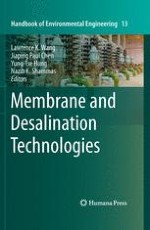In this essential new volume, Volume 13: Membrane and Desalination Technologies, a panel of expert researchers provide a wealth of information on membrane and desalination technologies. An advanced chemical and environmental engineering textbook as well as a comprehensive reference book, this volume is of high value to advanced graduate and undergraduate students, researchers, scientists, and designers of water and wastewater treatment systems. This is an essential part of the Handbook of Environmental Engineering series, an incredible collection of methodologies that study the effects of pollution and waste in their three basic forms: gas, solid, and liquid. Chapters adopt the series format, employing methods of practical design and calculation illustrated by numerical examples, including pertinent cost data whenever possible, and exploring in great detail the fundamental principles of the field. Volume 13: Membrane and Desalination Technologies is an essential guide for researchers, highlighting the latest developments in principles of membrane technology, membrane systems planning and design, industrial and municipal waste treatments, desalination requirements, wastewater reclamation, biofiltration, and more.
